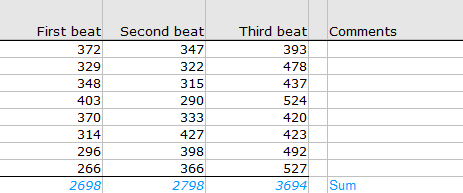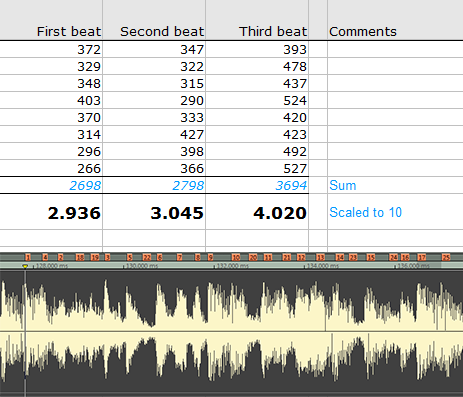| Main page Graphics Photography Music & Audio Audio Plugins Video Tools Web Design Documents Space Astro Amiga Funny Surreal Links & Contact |
Analyzing a RhythmIn case you wondered how I discovered the 3:3:4 shuffle, used in Mali and the surrounding area, here's how I analyzed a piece of music. For this example I'll use the song "Wayena" by Oumou Sangaré, but before I decided that this was the best notation, I had gone through a large number of songs from that part of the world, measuring each of them in this manner to verify that this is a recurring pattern. I even asked the Mandinka percussionist Salieu Dibba if this was really a specific rhythm, and not just normal triplets played in a bad way, and he confirmed that this is indeed a distinct and specific rhythm. He did not have a name for it, but explained that "people just know it when they hear it". First step is to isolate a part of the song where the basic rhythm is going steadily. In the beginning of a song, the musicians are often not quite in sync yet, so choosing a later part, where the groove is really going, will give a better result. Chosen part of the song: The next step is to place markers on each drum hit or instrument playing a new note. This can be quite tricky as there isn't always an instrument playing on each hit, and you must have a marker on each hit. You need to do this for appx. 10 bars or so, in order to have enough statistical data. The more bars, the more precise the result.  The next step is just as tedious, and takes some listening skill.
You have to have an idea how many drum hits there are per bar, and then create columns of numbers starting at each bar.
This song appears to be somewhat like triplets. Most musicians would probably even think these are triplets, but they are not.
because of this, I choose to create three rows.
Measure the distance (in milliseconds) from the first hit to the second hit. Put this value in the first column.
Now measure the distance from the 2nd hit to the 3rd hit. Put this in the 2nd column.
Measure the distance from the 3rd hit to the 4th hit (which is where the next bar begins.) Put this in the 3rd column.
Repeat until you run out of markers.
The next step is just as tedious, and takes some listening skill.
You have to have an idea how many drum hits there are per bar, and then create columns of numbers starting at each bar.
This song appears to be somewhat like triplets. Most musicians would probably even think these are triplets, but they are not.
because of this, I choose to create three rows.
Measure the distance (in milliseconds) from the first hit to the second hit. Put this value in the first column.
Now measure the distance from the 2nd hit to the 3rd hit. Put this in the 2nd column.
Measure the distance from the 3rd hit to the 4th hit (which is where the next bar begins.) Put this in the 3rd column.
Repeat until you run out of markers.
 When you have all the columns, sum up the numbers. In this example I reach the values 2698, 2798 and 3694.
The last number is larger than the first two, which would not have been the case for normal triplets from the western world.
If you chose the correct number of columns, these numbers describe the average "shape" of the rhythm pattern.
If you didn't pick the right number of columns, the numbers are entirely useless though.
When you have all the columns, sum up the numbers. In this example I reach the values 2698, 2798 and 3694.
The last number is larger than the first two, which would not have been the case for normal triplets from the western world.
If you chose the correct number of columns, these numbers describe the average "shape" of the rhythm pattern.
If you didn't pick the right number of columns, the numbers are entirely useless though.
The resultNow these numbers are quite an unpractical way to notate a rhythm. The challenge is to find a relationship between these numbers which can be expressed in smaller integer numbers without introducing too many rounding errors. In this case we find something unexpected: The numbers seem to fit the relationship 3:3:4. This is fairly surprising as this adds up to 10, which is not a very common number in music theory as we know it. We can now scale the numbers to this range (you can use OpenOffice Calc or MS Excel for this.) Again, the fact that this scales up to 10 is only the case for two of the rhythms I've uncovered. This number can be anything, so don't assume you're looking for 10 if you decide to try this with another song. I've found a rhythm in some traditional music from Chad which was in 4:2:3:3 and multiple (modern electronic) cumbia trival tracks from Colombia which were in 5:3:4, which somewhat resembles the 4:3:3 pattern that I found in a few west African songs.
 So when you play an entire bar of four beats, each beat is divided into three hits of uneven length, like this:
So when you play an entire bar of four beats, each beat is divided into three hits of uneven length, like this:

So, let's try applying this to some non-african music, and see if the correct "feel" is still there: Quantized example I: Quantized example II: Quantized example III: Generate MIDI groove patterns Website by Joachim Michaelis
|